You’re riding along on your bicycle in Louisville in October and November. It’s simply paradise, here in the River City.
And then Bam... Cold. Ice. Snow. Rain. Wind... ugh!
To any cyclist, this presents a few challenges and more than a few questions: What to wear and when? What bike to ride and where? Indoor or outdoor? Day or night? How to stay warm?
You can do this.
Cabin fever is real, people!
I want to keep riding no matter what the weather, but it has meant learning through trial and error about what to wear while biking in Kentucky during the winter. We have daily fluctuation in temperature, wind and sun that make it all but impossible to gear up without overdressing or underdressing. It takes practice. And most of the time I don’t head out on a ride if I know it’s going to be rainy from the start. When I have less time to ride and get desperate on rainy days, I go downtown with a few friends on mountain bikes and ride up and down through parking garages on weekends, when they are deserted.
In a major world tour like the “Giro d’Italia” during May or June, it’s typical to see professional riders climbing a mountain and reaching the top where the temperature is much cooler than where the stage began. As is custom, cycling fans stand at the summit on the edge of the road, shouting and cheering with sheets of newspaper (like the LEO) in their hands. The rider takes a couple sheets and tucks them under the jersey to break the wind for the long, frigid descent. Sure, the rock stars have their team guys up there, handing them a swanky team windbreaker or vest, but the fact that newspaper use still goes on makes an old cycling fan grin.
Low-cost and low-tech methods of staying warm, like using the newspaper windbreaker, or plastic shopping bag booties, are the inventions mothered by necessity. Devo had it right in the ‘80s wearing trash bags, as they were “Through being cool,” but they were making an anti-fashion statement, not keeping warm and dry. Other ersatz techniques for staying warm include oversize wool socks placed over cycling shoes with a hole cut out on the bottom for the cleat of your clipless pedal. Homegrown gear will get you by on the cheap for a while, but eventually a few cold-weather gear purchases per year from your local bike shop will have you geared up with options in no time.
HEAD, HANDS and FEET
If your head, hands or feet get too cold, your ride becomes torturous, and you’ll be looking for the shortcut home. Invest in headgear, gloves, shoes or booties rated for the temps you will encounter on your ride. Temperatures like 20 degrees require serious gear. Get as serious as the weather has become, and you will manage to have an enjoyable ride as long as you stay moving. Feet getting cold? Loosen your too-tight shoes, or try spinning faster. Increasing leg speed will generate heat and help warm you up.
Dress to strip
As the old saying goes: “Fifty degrees, cover the knees.” The upper-to-mid-50s is cold enough to wear more than a jersey and shorts if you’re one of those 20-somethings, or wear more if you’re an old timer.
Wear long pants, knee covers, knickers or homemade knickers out of a pair of old pants. A long-sleeve base layer under your jersey, wind breaker or vest, wool socks, cap, long-fingered gloves and maybe even toe covers are part of a 50-degree kit for a road ride. Make that a 40-degree kit for an off-road ride. A lower-geared trail ride with lots of inclines will have you shedding your wind breaker in 15 minutes or less.
Don’t underdress or overdress between 40 degrees and 20 degrees, ever. You’ll either freeze immediately or become sweaty, uncomfortable and freeze later. Find what combination works for you. Dress to strip by bringing such flexible options as arm warmers and a vest, instead of a full wind breaker, and a cap, instead of a balaclava. That way, if it warms up while you are out, you can lighten up.
Cycling jerseys come with so many pockets, you’ll have a place to stash all this stuff. Roll up clothing tightly so it stows away in back pockets. As it drops closer to 20 degrees, you may want to forget options and just go straight for the big guns: windbreaker-front pants over cycling shorts, an insulated jacket over jersey and base layer, a balaclava with insulated cap and wool socks with shoes a half size larger to make room for warm toes. Booties, or better yet, lined winter cycling shoes, which are on my bucket list.
When the ground is frozen or snowy, try mountain biking or cyclocross. You’ll stay warmer and learn more technical skills. Join a group or club night ride for the camaraderie, but also for the safety, visibility and help, if there’s a mechanical problem. Ride indoors on a trainer in your pain cave (basement or living room) with the digital inspiration of Zwift on a screen (zwift.com), or join a spin class at a gym. Constant pedaling on rollers is challenging but, if you master them in the winter, you’ll be a smooth spinner by spring, and it will show once you get back on the road or trail.
Winter doesn’t have to mean it is time hang up the bicycle. Continue enjoying the outdoors to maintain fitness, burn fat and hone the skills you’ll use the rest of the year.
There’s no such thing as bad weather, just bad gear! •






